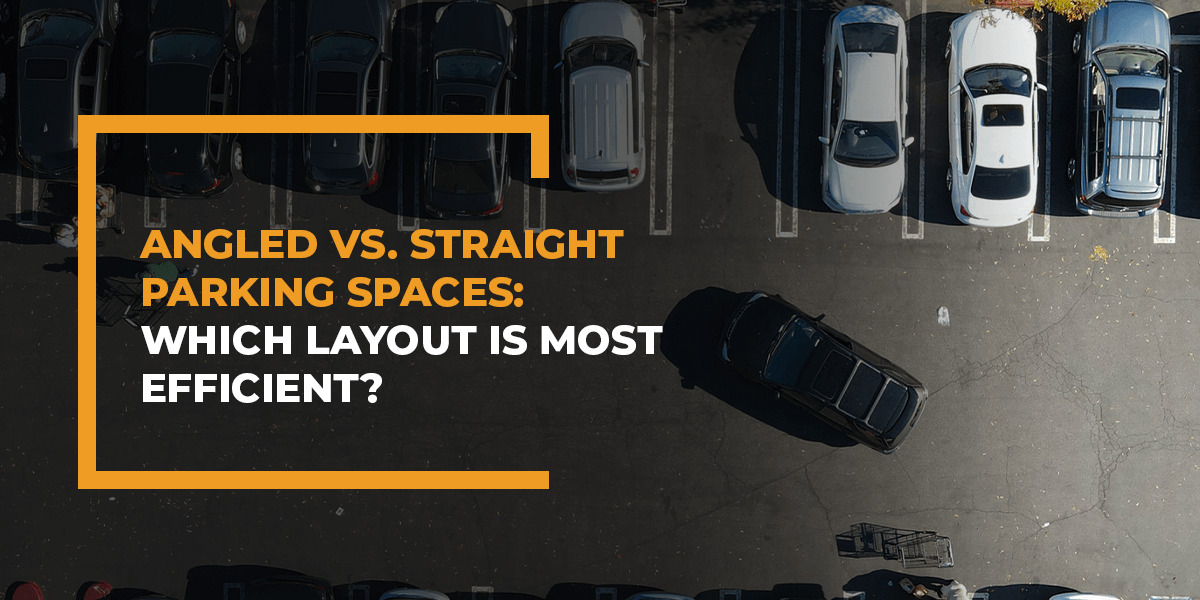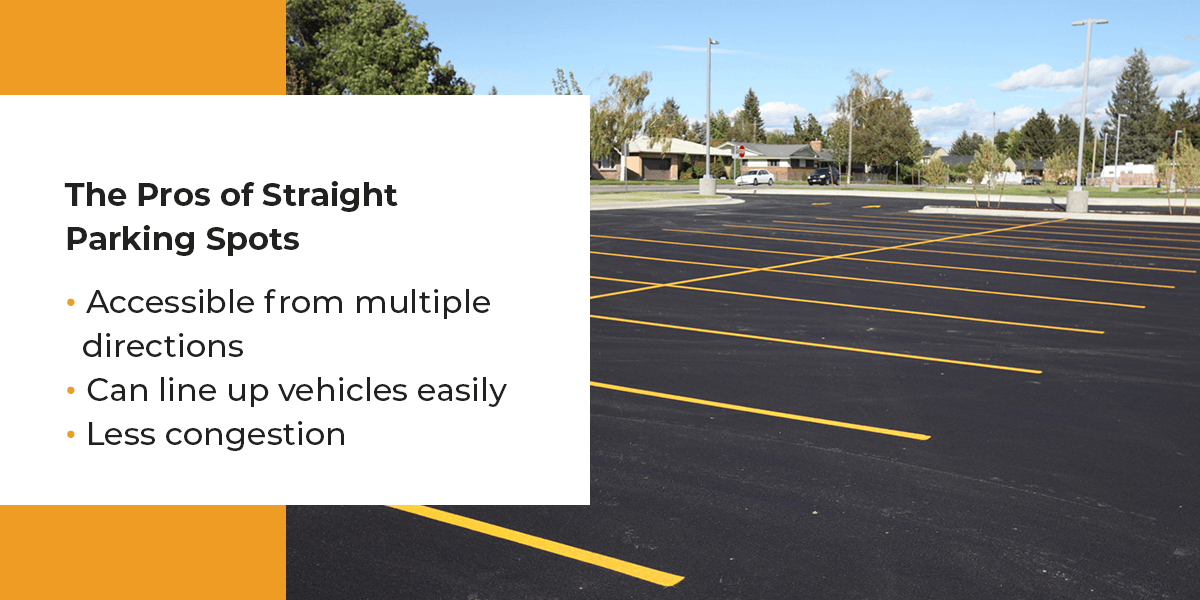Angled vs. Straight Parking Spaces: Which Layout Is Most Efficient?
Maintaining a high-quality parking lot for tenants is essential for property managers. With an accessible and spacious parking lot, you can make things easier for your tenants.
If you’re creating a new parking lot or rearranging the current one, you have many factors to consider. One particular consideration is the style of parking lot spaces. Most lots use either straight or angled lines to designate a parking space. But which kind is better, and how do you decide between the two?
Learn about the most efficient parking lot layout for the property you manage.
Angled vs. Straight Parking Spots: The Pros and Cons
Adding paint stripes to the parking lot at the property you manage is essential. They establish parking spaces and organize the lot into an efficient and safe area. But choosing between angled or straight parking lines can be tricky. Comparing the pros and cons of each can help you decide.
Here are the benefits and drawbacks of both options.
The Pros of Angled Parking Spots
Angled parking spots are a popular choice for many property managers. In this option, the spaces are set at diagonal angles rather than facing perpendicular to aisles. Angled spaces have many benefits, including:
- Easy to park: The angles often make it easier for tenants to park. Drivers don’t have to make a sharp turn when approaching the space because the lines are angled towards the vehicle. This design makes parking much less hassle for tenants, especially when pulling into a tight spot.
- Easy to exit: Diagonal spots are also easier for backing out. A diagonal parking lot is usually staggered, meaning that vehicles don’t sit exactly next to each other. This format gives drivers more room and allows them to see better when backing out of the space. And the better drivers can see, the less likely collisions or accidents will happen.
- Less chance to get blocked in: The staggered design of angled spots also reduces the opportunity for vehicles to get stuck behind another vehicle. Because there’s more room between cars, it’s much simpler to pull out even if one car is very close to other cars.
- More spaces can fit: Angled parking spots typically allow more cars to fit in the lot, making angled parking an excellent option for property managers because more tenants can use the lot without having to expand it.
The Cons of Angled Parking Spots
However, angled spaces also have a few drawbacks. Here are some examples:
- One-way traffic lanes: Angled spots face a specific direction and are usually only accessible by one traffic pattern. If a driver approaches the parking lot from the wrong direction, parking could be difficult or impossible. This can make angled lots inconvenient and add time to a tenant’s commute.
- Can’t line up vehicles with other cars: This type of lot also requires keen attention to design because the cars don’t line up with one another. Ensure that vehicles can park without sticking into the aisles, or this could cause collisions.
The Pros of Straight Parking Spots
The other primary option for parking lot design is straight spaces. These spots have straight paint lines instead of diagonal, and they are also an excellent option for commercial and multifamily residential properties.
Here are some advantages of straight parking spaces:
- Accessible from multiple directions: Unlike angled spaces, drivers can access straight ones from any direction. No matter how they approach the spot, they can easily maneuver the vehicle between the lines.
- Can line up vehicles easily: Straight parking designs line up cars evenly without sticking out. It’s also sometimes easier to park because drivers can use other cars as a reference.
- Less congestion: This style is often much faster than angled parking because it allows for two-way parking. Two lanes of traffic can move in and out at all times, making it easier to exit the parking lot.
The Cons of Straight Parking Spots
Even with these positives, straight spaces for parking also have some disadvantages, like:
- Taking up more space: This layout usually takes up more room in a parking lot. You can’t fit as many spots into one parking lot, which might limit your parking availability for tenants.
- Wider turning radius: Drivers will have to make bigger turns when pulling into or out of these spots. The wider radius could result in more accidents because cars need more space.
- Harder to exit the space: It’s more difficult for drivers to see as they back out of straight spaces. And while the two lanes of traffic can be a benefit, it also creates more opportunities for accidents if drivers don’t look before pulling out.
Straight vs. Angled Parking Spot Dimensions
Another way to compare these two parking options is by looking at their dimensions. Here’s an overview of how the sizing differs:
- Angled spaces: Since angled parking dimensions tend to be slightly smaller, you can typically fit more in the entire parking lot. So, you can guarantee more parking availability for tenants, but they might not have as much room while getting in or out of their cars.
- Straight spaces: These take up more room, meaning you can’t fit as many into one lot. But the extra room often makes the space more user-friendly because tenants will have a larger area to open their doors and get out of their vehicles.
Which Layout Is Right for You?
Both of these parking space options have pros and cons. This means that neither layout will be perfect for all parking lots. It’s typically best to consider your property’s circumstances and weigh which option would suit your situation better.
Consider these factors as you decide which layout is best for you:
- The size of the lot: One significant consideration is the lot’s size. If you have limited space but want to add as many spots as possible, the angled design might be best. But if you have a large amount of space, you might opt for straight-lined spots.
- The estimated number of users: Perhaps the most significant factor affecting your parking lot design is the number of people who will use it. You can use this number to design your parking lot. For instance, if you have many tenants who need parking, you might use angled parking spaces to ensure they will all have room. You might be more favorable toward straight parking spots if you have enough space already. Either way, knowing how many people require parking is essential for your overall design.
- The entrance to the building: You want your tenant parking to be as convenient as possible, so it’s best to plan for a parking lot near the property entrance. That way, tenants won’t have to walk far distances after parking their vehicles for the day.
- Traffic patterns: Lastly, consider the typical traffic patterns of your property. While angled parking spaces typically require one-way traffic, straight spaces accommodate two lanes. If your multifamily residential or commercial property follows a particular pattern or needs a specific amount of space due to a high volume of vehicles, consider that as you choose.
Overall, there isn’t one most efficient parking lot layout. Both straight and angled parking spaces are beneficial in different ways. It’s ultimately up to your preferences and circumstances to determine which option would suit the property best.
Contact ToriTom Services Today
If you need to install a new commercial or residential parking lot, look no further than ToriTom services. We offer a wide range of parking lot services, from asphalt and concrete repair to entire parking lot installations. We can help you determine what layout would optimize your lot and can guide you through the whole process. Our expert installers can create sleek and high-quality lots to enhance the property you manage.
For more information or to get started, contact ToriTom Services today.



